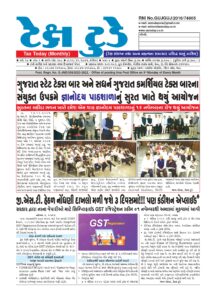Appeals and Writ Petitions under GST: A Complete Guide for Businesses

 By Adv. (CA) Hirak Shah
By Adv. (CA) Hirak Shah
- Brief Introduction
- The Goods and Services Tax (GST) has simplified indirect taxation in India, but disputes under GST are common. Businesses often face issues such as wrong input tax credit (ITC) denial, penalties, or cancellation of GST registration. To handle such disputes, GST law provides a structured appellate mechanism. In certain exceptional situations, taxpayers can also approach the High Court or Supreme Court via writ petitions. This article explains everything you need to know about appeals and writ petitions under GST, in a simple, step-by-step manner.
- Suppose a GST registered person receives a GST order demanding ₹50 lakh in tax due to ITC mismatch and the registered person believes it is completely wrong. What are the options at his disposal?
- Appeal against the order using the statutory appeal mechanism under GST.
- Move a writ petition in the High Court, but only if there is a fundamental legal flaw.
- In short, appeals are the primary remedy, while writ petitions are like the emergency exit.
- Appeals and Writ petitions
- In any tax law, there could be disputes in relation to various aspects such as:
- Constitutional issues;
- Jurisdictional issues;
- Law not clear / Interpretational issues;
- Tax disputes – rate / classification / valuation / ITC etc;
- Contravention of statutory provisions
- Imposition of penalties
What is an Appeal?
- Any appeal under any Law is an application to a higher court for a reversal or modification the decision of a lower court. Appeals arise when there are any legal disputes.
- Disputes – owing to obligations under law:
- Tax related aspect
- Procedural aspect
- Provisions of Section 107 of the CGST Act, 2017 prescribes for challenging any order by way of an Appeal in Form GST APL-01 within 3 months from the date of order.
- The GST appellate framework is a multi-level Appeal system which is bifurcated broadly into 4 levels.
- First Appeal – Appeal to Appellate Authority (Section 107);
- Second Appeal – Appeal to Appellate Tribunal (Section 109);
- Appeal to High Court (Section 117);
- Appeal to Supreme Court (Section 118)
First Appeal
- The person aggrieved by any order shall proceed to challenge the order in first appeal by making payment of 10% of the disputed demand as pre-deposit and filing the appeal within a period of 3 months from the date of order.
Second Appeal
- In case any person is aggrieved by the order of the first Appellate authority, he may challenge the said order before the Appellate Tribunal in second appeal upon payment of additional 10% of disputed demand as pre-deposit and filing an appeal within a period of 3 months from the date of the impugned order.
- It is pertinent to note that as of now, the GST Appellate Tribunal is not yet operational and with a motive to reduce burdens on the Hon’ble High Courts, the Department has issued GST Circular No. 224/18/2024 – GST dated 11th July 2024 which prescribes payment of additional 10% amount of disputed demand as pre-deposit once the first appeal has been rejected in order to obtain stay from departmental recovery proceedings.
Appeal to High Court and Supreme Court
- In case such person is still aggrieved by the order of the Appellate Tribunal, he may prefer an appeal before the Hon’ble High Court and subsequently before the Hon’ble Supreme Court wherein such appeal shall involve a substantial question of law.
What is a Writ?
- Apart from appeals, businesses sometimes go directly to the High Court (Article 226) or Supreme Court (Article 32) by filing writ petitions. A writ is a formal order issued by a Court. Any order, warrant, direction, and so on, issued by the Supreme Court or High Court is called a Writ.
- Writ petition can be filed in the Supreme Court (Article 32 of the Constitution) and High Court (Article 226 of the Constitution) of India when fundamental rights are violated. High court (Article 226) can also be invoked for violation of any Constitutional right.
What are the various types of Writs
- Writs can be of following types:
- Habeas Corpus – To produce the body. Issued in case of illegal detention of a person.
- Mandamus – “we command” or “we order”. Issued by Court to a public authority or lower court to perform a public or statutory duty.
- Certiorari – Quash an order passed by an inferior court.
- Prohibition – Prohibit lower courts from doing an act against natural justice or outside their authority.
- Quo Warranto – To stop a person or restrain him from holding office that he has no authority to hold.
General Principles on Writ
- Following points are important to note in relation to writs:
- Writs may be maintainable or non-maintainable.
- Writs may be admitted, disposed of with direction or dismissed
- Court cannot entertain a writ petition merely because petitioner is aggrieved with any order of authorities unless the order is shown to be either non-speaking/unreasoned or without jurisdiction or without jurisdiction or vitiated by non-observance of principles of natural justice or by fraud or actuated by malafides.
When are Writ petitions allowed?
- Courts generally say: “If an appeal exists, use it.” But writs are entertained in cases like:
- Violation of natural justice (no hearing given).
- Orders passed without jurisdiction (beyond legal power).
- Blatantly illegal or arbitrary
- Challenges to the validity of laws/notifications.
- Appeal remedy is not effective or practical.
Example: If your GST registration is cancelled without giving you a chance to reply, you can directly file a writ in the High Court.
- There have important Court rulings as well of the Hon’ble Supreme Court whereby it is stated as under:
- Commercial Steel Ltd. (2021, SC): Writs should not replace statutory appeals unless exceptional grounds exist.
- Radha Krishan Industries v. State of Himachal Pradesh (2021, SC): High Courts should interfere only in cases of violation of natural justice, lack of jurisdiction, or constitutional issues.
- Conclusion
The GST Law was introduced with the moto of “One Nation, One Tax” with the primary objective of providing ease of business to the country at large. In the last 8 years of GST, there have been significant steps taken by the Government in this regard major one being as recent as the latest 56th GST Council Meeting whereby the GST Council has proposed GST rate rationalization from a 4-Tiered tax rate structure to a 2-Tiered tax rate structure. However, only time will tell whether such rate rationalization will turn out to be a boon or a bane for the economy.
The views prescribed hereinabove are strictly based on the author’s own interpretation of the legal provisions and their implications and do not have any legal impact.
(Author is a Chartered Accountant and Practicing Advocate in Gujarat High Court)





